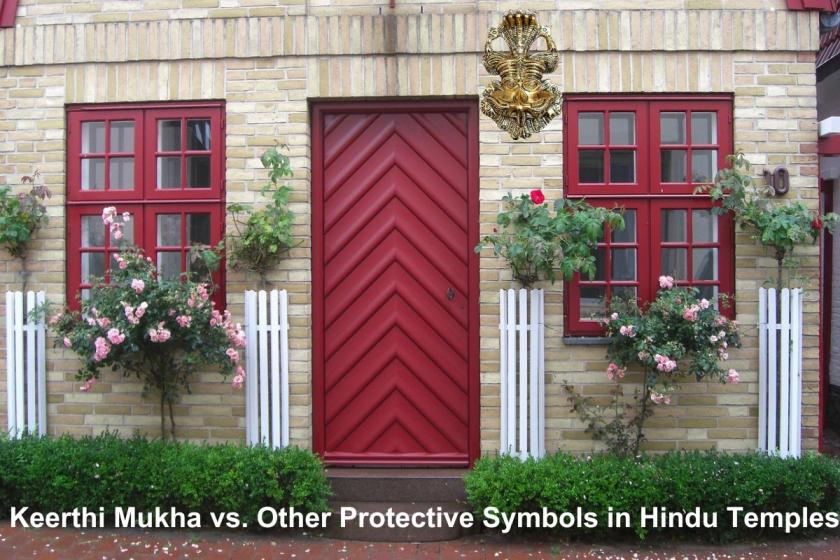Hindu temples are not just places of worship but also centres of spiritual energy. To maintain this sacred energy, protective symbols are placed at the entrance and temple premises. One of the most striking symbols is Keerthi Mukha, a ferocious, wide-eyed face that guards against evil forces. Hindu traditions, however, use many other symbols to provide divine protection. This article talks about why Keerthi Mukha is significant and how it compares to other protection symbols in Hindu temples.
The Significance of Keerthi Mukha
Keerthi Mukha is a supernatural beast with a terrible face, having bulging eyes and fangs. It originates from Hindu mythology, where Lord Shiva, to eat a demon, brought it into being. After eating the demon, Keerthi Mukha developed an insatiable hunger. Shiva thus gave it a place to sit at temple doors so that it could forever guard holy grounds.
Various temples also have Brass Keerthi Mukudu, a brass replica of this holy face. Brass is also one of the most utilized temple relic materials because it is highly durable and sacred. Brass Keerthi Mukut is another form of ornament used in temples. The metal statues are highly decorated to ensure that Keerthi Mukha ferocity is sustained so that the strength of protecting its wearers is guaranteed.
Keerthi Mukha symbolizes protection as well as destruction. Although it seems frightening, it is not malicious in nature. Instead, it is a reflection that sacred energy guards those who visit with pure intentions. It also repels evil spirits, again repeating the spiritual security of the temple.
Other Protective Symbols in Hindu Temples
While Keerthi Mukha is a powerful guardian, Hindu temples also employ several other symbols of protection. These symbols are rich in mythology and religious faith and each has a unique function.
Nandi – The Sacred Bull
Nandi, the divine vehicle of Lord Shiva, is commonly placed at temple entrances. It represents strength, devotion, and vigilance. According to Hindu beliefs, Nandi watches over the temple and prevents negative energies from entering. Devotees often whisper their prayers into Nandi’s ear, believing he will carry them directly to Lord Shiva.
The Swastika – A Symbol of Auspiciousness
The swastika is one of the oldest and most powerful symbols of Hinduism. It is found on temple gates and walls and represents prosperity, harmony, and divine blessings. Its four arms signify stability, dharma (righteousness), artha (prosperity), kama (desires), and moksha (liberation). The swastika is also believed to attract positive energy and repel evil.
Drishti Ganesha – The Remover of Evil Eye
There are special Lord Ganesha placed in some temples called Drishti Ganesha to ward off the evil eye. Drishti Ganesha possesses a threatening face, which is meant to ward off negative energies. Similarly, people use the old evil nazar kavach to ward off bad luck and negative energies. The protective amulet is placed in homes and temples to grant spiritual well-being.
The Role of Evil Faces in Protection
Keerthi Mukha is only one of the many symbols that utilize an aggressive-looking face for purposes of defence. Some other Hindu practices also use horrific faces as a means to scare away bad influences.
Bhairava – The Fierce Form of Shiva
Bhairava, the fierce incarnation of Lord Shiva, is typically depicted with a ferocious face. Bhairava temples are utilized as spiritual guards. Bhairava is considered to be revered to eliminate obstructions and shield one from bad luck. Bhairava is also the embodiment of time and justice and prevents evil forces.
Raksha Masks – Keeping Evil Forces Away
In some places, temples display Raksha masks, which are identical to Keerthi Mukha. The masks are very exaggerated with broad eyes and sharp teeth. They are used for the same reason as evil face protection, i.e., to frighten away and ward off evil spirits. These masks are commonly used in South Indian temples and a few Buddhist traditions too.
Why Do Temples Use Multiple Protective Symbols?
Hindu temples consist of different protective symbols because different energies require different counterforces. There are different guardians so that there is complete spiritual protection.
Additionally, every god is defensive in a different way. Lord Ganesha clears away obstacles, while Nandi stands at the entrance of a temple. Protection against evil so that evil never gets into religious premises is provided by Keerthi Mukha, Bhairava, and Raksha masks.
Besides, such symbols enhance the sacred atmosphere of the temple. They guarantee worshippers' protection in divine benevolence. Furthermore, these protective elements possess a close nexus with cultural traditions and historical convictions.
The Role of Protective Symbols in Everyday Life
Apart from temples, defensive symbols are also important in daily life. Antique evil nazar kavach is employed by many to protect their homes against the evil eye. Similarly, miniature versions of Brass Keerthi Mukudu are placed at entrances to maintain energies positive. All these indicate that ancient traditions have a lasting influence on modern society.
Spiritual protection is not limited to temples. Many houses worship Bhairava, place swastikas on their walls, and possess Raksha masks at doorways. These things build the belief that all divine powers always protect people who approach with clean hearts.
Conclusion
Keerthi Mukha remains among the most widely recognized protective motifs in Hindu temples. Its menacing appearance serves as a guardian against everything evil. However, some other protective motifs also play a major role in temple protection. Nandi, the swastika, Bhairava, and Raksha masks all serve spiritual protection in different ways.
The existence of ancient evil nazar kavach and evil face protection symbols also increases spiritual safety. When these symbols are interpreted, the faithful can better comprehend their inner significance and divine potential. Hindu temples are not only places of worship but also sanctuaries of good energy, guarded by these ancient symbols.

